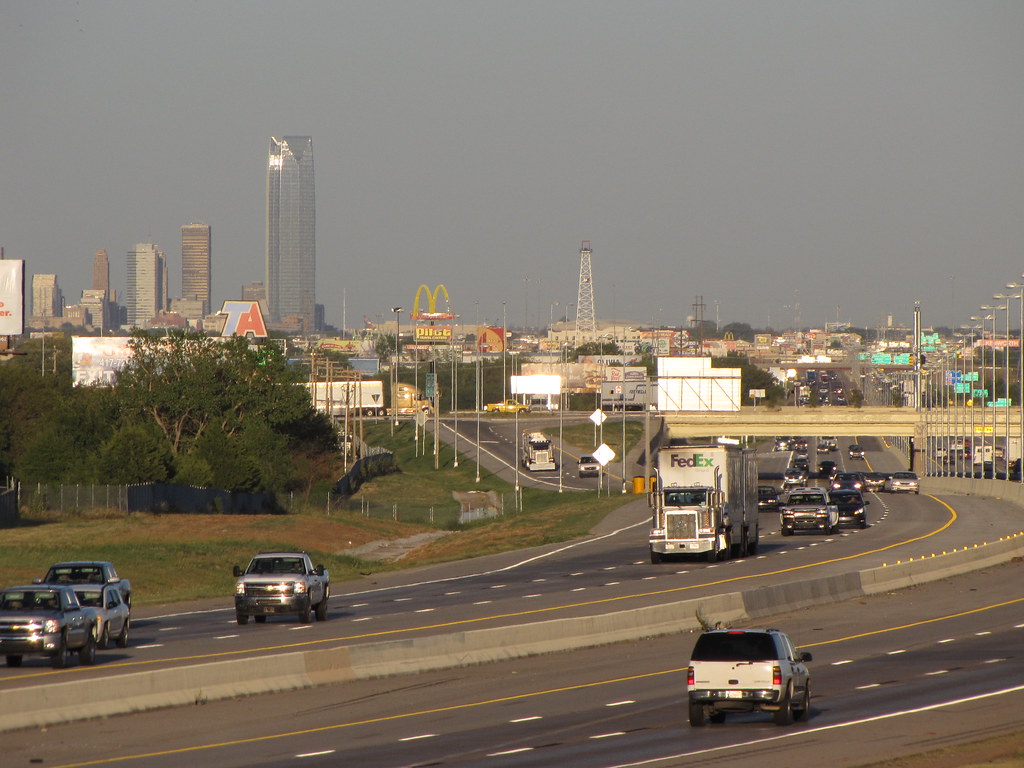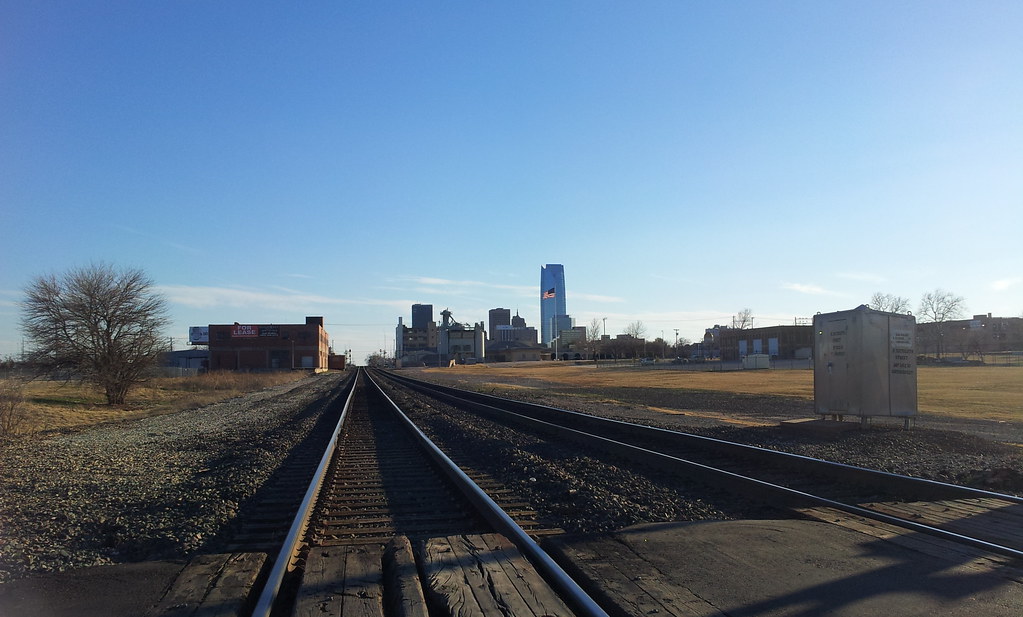










It seems photoshoped, the downtown buildings do not look that large several miles east of Morgan's exit and those trees & billboards on the north side of the interstate are not at the Moran exit, another thing is the interstate is now concrete at Morgan and Devon was not finished the last time it had an asphalt top.

Extreme telephoto lenses have such an effect. I'd bet that the camera was several miles west of the Morgan Road interchange, possibly all the way into Yukon, to create such huge foreshortening.
I'm curious as to what focal length telephoto was used for this. The biggest one I ever owned was around 1.3 meters, not mm, mounted on a Konica 35 mm; I used it to shoot closeup photos of birds at a distance of about 150 feet. The lens itself mounted on the tripod and the camera simply hung off the back of the lens barrel. For this shot, though, I suspect a much longer lens was used!
So it was taken from here?
IMG_7871 OKC Skyline fr Sara Rd I40 | Flickr - Photo Sharing!
Read the camera settings.
http://www.flickr.com/photos/7340932...th/8353146903/

So it was only a 100 mm lens setting; amazing! However the sensor area in today's digital cameras is much smaller than the 24x36 mm size of the film cameras, so the lens focal length is effectively multiplied by the difference in size. That's probably more like a 250-mm lens would be on a film camera; unfortunately I don't know the actual multiplier ratio although many camera spec sheets provide a table...
Great set of photos from that distance!
In post # 180, all those vehicles west bound (coming at us) is just not right. There is like 4 or 5 lanes across.
I think this effect was explained on another thread somewhere. It has to do with the kind of lens Jim Kyle was talking about. I am no expert in photography so I know nothing of this.











Those are absolutely not photoshopped.











You are correct, downtown does not appear to be that big, because you are further away from it.
When you magnify your vision, distant objects fill the background. In fact, the lens itself is not doing anything unnatural. When you look at distant objects (from the naked eye), there is no distance reference. Without distance reference, objects far away appear to be stacked on or behind each other with little loss in relative size or scale.
For example, the moon is the exact same size on the horizon as it is when it is directly overhead. The moon appears larger because you have a objects to relate to on the ground, when it is overhead you have no comparable objects so it appears smaller. It is an optical illusion that it appears larger, it takes up the same amount of sky on the horizon as it does overhead....
Leading to this....
Go to an empty field with hay bales. Some are close and some are far away. Line yourself up to place a distant haybale right "next" to a considerably closer one. Stand 200 feet away from the closest one. Now imagine you can "zoom" in close up. The distant one will appear to be only feet behind the close one. Yet when viewed perpendicular or diagonally instead of parallel they are actually further apart. When you place distant objects in parallel or close parallel to each other and zoom in, you eliminate or reduce depth perception and objects no matter how far apart can appear to be very close.
The pictures posted are zoomed in to a very small "patch of eyesight". Skyline is the distant haybale, the bridge and vehicles are the closest haybale. They are parallel and zoomed in. Our eyes don't zoom, we have wide angle vision and see a much broader picture. if our eyes were set to 160mm and had that magnification, we'd see everything as in those photos, and would not be able to see anything 300-400 feet in front of us very accurately.
Those are absolutely not photoshopped.
It's a long distance telephoto lens on a digital single lens reflex (D-SLR) camera and is definitely not photoshopped.
On my DSLR the multiplication factor is just under 4, so the 100-mm lens used to take the photo would be the equivalent of a 400-mm lens on a 35-mm film SLR. For information, the longest lens in common use on 35 mm cameras is 135 mm, so this one is about triple the magnification you usually see in telephoto shots.











Most cameras use a crop factor of 1.6x, not sure where you got 4x from?
The EXIF data for photos I shot recently shows a focal-plane diagonal of 11 mm, while the diagonal of a 24x36 mm frame is 44 mm. That's where the 4x figure comes from. The maximum wide-angle setting has focal length of 9 mm, which corresponds to a 35 mm focal length, as a check on the calculation.
However different DSLRs probably have different-sized sensors, so this would apply only to the rather ancient Olympus E-10...


Yep, every technology has its own jargon! EXIF data is a lot of information that's recorded by the camera in the image file, alongside the image itself, and is quite handy for later reference. Professional image editing programs can read and report this data. Among other things, it records the date and time at which the image was taken, plus lots of technical detail about the camera settings. The "diagonal" is exactly like the "size" rating for TVs; a 40-inch TV screen is less than 40 inches wide, because that measurement is made diagonally across the face of the screen. The "focal-plane" is the location of the sensor that actually sees the image, and focal length is the distance from the optical center of the lens to the face of the sensor. All of which is probably lots more than you ever wanted to know.
One of my favorite bits of photo jargon is "circle of confusion" which actually refers to what makes an out-of-focus picture blurry. Each point of light forms a circle rather than a point, and they overlap and blur each other out. However, "circle of confusion" always reminds me of my mental state when I was first encountering all these terms...going round in circles, quite confused by it all!

Thanks for the explanation. Now I totally understand everything. (NOT)

very cool

wow very cool pics
When at or near the horizions, light from the moon (and sun, for that matter) pass though more of the earth's atmosphere, scattering more of the light and making their disks look bigger than they really are. This phenomenon also causes the rising and setting sun and moon to look more reddish, as the atmosphere scatters more blue light than red. As they rise in the sky, they penetrate less of the atmosphere and less light is scattered. There's your science lesson for today.











These scientists disagree (and NASA also referenced this article). In fact, they say the opposite of what you do. The moon should appear smaller on the horizon due to atmospheric refraction.
The Moon Illusion
The percentage of sky the moon occupies is virtually the same regardless of it's position in the sky. The moon appears larger near the horizon because we have visual references, and the lack of references when directly overhead makes it appear smaller.
Anyway, careening off-topic.
I took this picture on Sunday afternoon.


2/15/13 - HDR by racnokc, on Flickr
2/15/13 - HDR by racnokc, on Flickr
There are currently 1 users browsing this thread. (0 members and 1 guests)
Bookmarks